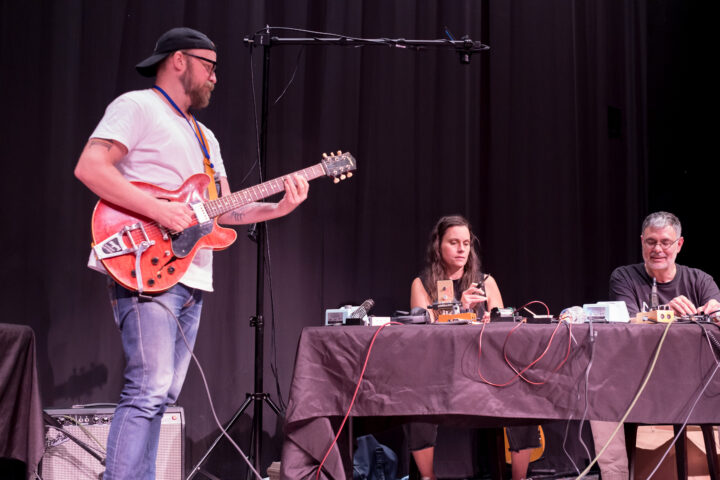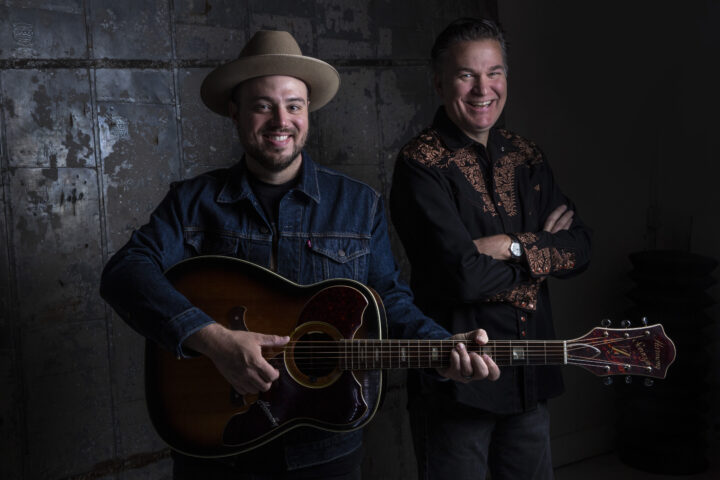Tommy Emmanuel is a force of nature. In addition to being one of the world’s greatest guitarists, he’s also one of the most enthusiastic. He brims with enthusiasm and seems to truly love his job, his guitars, and his collaborators. On his latest album, Accomplice Two, he gets to share the spotlight with a bevy of his friends and heroes, including Billy Strings, Molly Tuttle, Michael McDonald and Little Feat. It’s great.
Last month, Tommy and I had a Zoom chat to talk about the album (out now), the art of collaboration, the dangers of overplaying, and a lot more. Fans of the CGP should know that Tommy will also be performing at our Chicago Fretboard Summit this August 24-26, 2023 at the Old Town School of Folk Music.
Fretboard Journal: Tommy, how long has it been since Accomplice One?
Tommy Emmanuel: It was in 2019. ’18 was the album with John Knowles. And then out came Accomplice One, and then Best of Tommysongs, and all the other Accomplice series. Things that I did during COVID.
FJ: With the name Accomplice One, it seemed to imply that there would always be a sequel?
TE: Yeah. I just enjoyed making it so much and it was challenging. It was challenging to work with artists, some I had never worked with before. Some I was very familiar with and very close with…and just finding the right song and all that stuff. It was a wonderful kind of challenge that a guy like me likes.
FJ: What came first, the song or the collaborator?
TE: Usually the collaborator. In the case of Jorma Kaukonen, we did the song, “Another Man Done a Full Go Round,” Jorma did that on one of his albums many years ago. It’s a Roy Book Binder song. I just fell in love with it when I heard it.
I asked him, “Do you think we could have a go at doing that?”
He said, “Sure.”
So I got a good take of the two of us playing guitar and him singing and then I decided I would put a little bass and drums on it. We didn’t use a click track or anything like that, so you’re almost playing and singing. And, like a typical blues guy, he sings and he speeds up…you know what I mean? So I had to try and grab the track and bring it in a little bit. It’s all over the place. If you put a click on it, it’ll be all over the place, but it sounds like a band. I followed the two guys playing guitar when I played drums, and I made it sound like a band.
FJ: That sounds fun. How often do you get to play drums these days?
TE: Not so often, unfortunately. But I love playing drums. I’m a drummer and a bass player who plays guitar.
FJ: It all makes sense when anyone hears you play that those three things come together.
TE: When I play, I think like a band. I never think like it’s just one guy and a guitar. You know what I mean? It’s all going on in here. When I’m playing a tune, I’m hearing all the parts and I’m feeling the whole thing as I’m playing it.
FJ: You’re a conductor.
TE: Kind of. I’m a lead singer, and then I’m the accompanist, then I’m the timekeeper, and then I’m the bass man. And I’m trying to find ways of making it all fit together in a beautiful package.
FJ: Were all these tracks recorded at the same studio?
TE: Most of it was done here in Nashville. I used OmniSound Studios. I [also] used Ocean Way, which I love. I also recorded out at Richard Smith’s studio, Tunesmith. And then I went to LA to my friend Marc DeSisto and did all the mixing and the mastering.
FJ: Do you have one microphone you love to use for guitar?
TE: It depends on who’s engineering. It’s all about how good the engineer is and what he does. For instance, when I record at OmniSound, I always use Rory Rositas. He’s the go-to guy at Omni and he uses four microphones on me. He’ll use a pair of DSPs and then he’ll have a U47 in the middle, and then behind that, he’ll have a ribbon mic, just to give it a bit of grit. Between the four microphones, I get one sound that I love. That’s how Rory does it.
When I record over at Richard’s place, I usually use Brad Benge. Brad uses two microphones and gets an equally fabulous sound.
And then when I record guitar with Mark DeSisto in Los Angeles, he uses one microphone on me and gets a totally fabulous sound. So it’s about the engineer.
I do know what I like. Give me a good pair of Neumann KM 184s. One pointing that way and this one pointing that way. A good microphone is the way to do it properly.
FJ: How many guitars did you use for this record?
TE: There was a lot of bluegrass on this record…the stuff I did with Billy Strings and Molly Tuttle. For those, I used a real traditional-sounding guitar. It’s like a ’30s Martin 000-28, but it’s made by Pre-War. They made it for me. It is based on the one that David Grisman loaned me when we did our album together. He had a 1934 000-28 which was spectacular. But this guitar that Pre-War made me, it’s even better. So it’s pretty amazing.
So I used that. I used my Larrivee on a few tracks. And I used my main Maton guitar that I tour with. I record with that just for the mic on it. It sounds great.
FJ: Did Pre-War try to mimic the marks and the scratches on the original when they replicated it?
TE: They made their own. They baked it and they aged it. And they used the old Brazilian rosewood that they got from Martin some 40 years ago. And I tell you, that guitar, if you played it, you would think, “Oh my God, this is the best Martin I’ve ever played.”
It’s a replica of a real great guitar, but it is so good.
FJ: What’s the tonal difference between the Larrivee and the Maton?
TE: The Larrivee has a complexity and a sweetness to it. On the track with Sierra [Hull], a song of mine called “Precious Time,” that’s my Larrivee, because it’s deep, down to drop D. I just play really gently with it and it sounds beautiful.
FJ: What was the process behind this record like? Let’s use the Billy Strings track as an example. Billy agrees to be on this record and you start talking. How did you hone in on the song that you did?
TE: Well, let’s backtrack a little bit. I met Billy at MerleFest about seven or eight years ago when he was a young man and he was hanging around the side of the stage waiting to be called up, hanging there with his guitar, looking over.
Bryan Sutton had said to me, “You should get Billy up. He’s great.”
So I got Billy up to play with me, and we did “Guitar Boogie” and “Working Man Blues,” and stuff like that. He just tore the hell out of it. The next time I saw him, we got up and played “Black Mountain Rag” together.
So the process was this: Billy was taking off like a rocket and selling out shows everywhere.
I said to him, “I just need you for a morning. Come in and we’ll do “Doc’s Guitar” into “Black Mountain Rag.”
So he played a show here in town in Nashville and came out of the studio the next morning, and we were all set up. Two mics for him. Headphones. I did a sound check on them, got them all good, I’m around the other side. We put a baffle between us, so we could look over and see each other.
I started playing “Doc’s Guitar” and I said, “Why don’t you take the bridges?” So he took that, and that’s all working. “So we’ll go through twice, then I’ll lead you into “Black Mountain Rag,” and then you take it. And then you play it, and I’ll play rhythm. And then I’ll take a solo where when it goes to G, and then we’ll come back to C and take it out.”
So we ran it down once. It all seemed to fit really well. The next time we ran it down was the take.
FJ: You make it sound so simple.
TE: Well, when you work with someone who can play like Billy, you just use your imagination and not waste any time. I never waste time in the studio. I’m like, “Let’s get it done.” The thing I love about Accomplice One and Two is that I never manufacture stuff. When I did the track with Billy, that’s us playing live. There’s no dropping in and fixing all the things. That’s what we played.
When I played the song with Molly, that’s the take. I overdubbed my vocal harmonies, because I just wanted to play, and then I could work out the harmonies. But her part and my part were live.
When I did the track with Little Feat, the whole band played live and then we did all the backing vocals. We call them “party vocals,” like a bunch of guys at a party singing together all around one mic.
That’s the thing I love about this kind of recording and how I like to make records is capturing a performance. Going on Pro Tools and fixing stuff up, and sending it to Sweden for some guy to stick a saxophone on? I got no time for that stuff. I’ve done it. That’s how I did the Michael Jackson track when I played on Michael Jackson’s record. The producer was in LA and the track was emailed to me in London. I put my part on and emailed it back, and he put it in the track.
FJ: You made the Billy Strings track sound easy. And I know that when you and any number of pickers get together, fireworks are going to go off. There’s a magic. Is it actually harder for you to play on something like the Michael McDonald track [“Someone Like You”], where you have to slow things down? Is that a different side of your brain, where you’re thinking more as an arranger and less like a picker?
TE: That’s a great question. The Michael McDonald track was a labor of love for me. Michael sent me that song, “Someone Like You,” and the demo was a little drum machine, his piano and his vocal. That’s it. So at least it was all in-time and all that. We had that little drum machine, which I actually kept and used on the start of the track when I did the mix.
Talking about the guitars on that track, I actually recorded it three or four times. I played a steel string acoustic as the lead guitar around the vocal, and it just didn’t sound like it was working to me.
So I thought, “I’m going to be a bit daring here.” I got my electric guitars and my little Fender amp and some pedals, and I did a kind of fusion, like a Larry Carlton, Robben Ford kind of sound. I liked it, but when I came back to it, my instincts told me it was too much. I played too much. It was too busy.
So I lived with it for a little while. Once there was a deadline, I said, “I think I know what to do.” I grabbed my nylon-string guitar. I did two passes and I got it. Boom, boom, like that. As soon as I started playing nylon and playing around his vocal, just real simple, as tasty as I could be, the whole thing just came together.
I played bass and drums on that track as well. When we mixed it, I put his vocal right here in your face. And then I constructed the backing vocal so it was like three of him like that.
But the nylon string, I just played real soft and got right in on the mic as if I was whispering at you. I did labor over that track because Michael McDonald is one of my all-time heroes as a writer and a player and a singer. But I also wanted the magic to be there, and the magic wasn’t there until I played nylon string.
FJ: You and Sam Bush did the “Yeller Rose of Texas,” a Homer and Jethro song.
TE: Yeah, Homer and Jethro.
FJ: Were you hip to Homer and Jethro growing up in Australia?
TE: Totally. I was hip to Homer and Jethro by the time I was five! I’m not kidding. Homer and Jethro’s At the Country Club came out in about 1960 or ’58…something like that? I was a little boy. I knew all their jokes and I knew all their songs. I knew the original song and I knew how they’d cleverly rewritten it, and all that stuff.
I was totally hip to them. And I was hip to the fact that Homer and Jethro played with Chet Atkins on all these early records, and that Chet and Jethro married twin sisters. And Jethro Burns…what a genius he was. Homer was a big influence on me, on rhythm playing.
Sam’s a big Jethro Burns disciple, and every time we’d see each other at some bluegrass festival somewhere, we’d start singing Homer and Jethro songs. He knew them all like I knew them.
FJ: Did Homer and Jethro records get sold in Australia or are you just an anomaly in so many ways?
TE: Well, my mum and dad loved all kinds of music. My mum had records. I still don’t know where she got them. She had Grady Martin & His Slew Foot Five, a record that Grady did as a band with a bunch of Nashville guys. That was one of the first records I heard. And Homer and Jethro At the Country Club.
FJ: I think you and Sam need to do a Homer and Jethro tribute album.
TE: Well, we could try. But I’d love to do a serious album with Sam, with some really good tunes. He’s just got such a great style and he’s wonderful to play with.
FJ: What are you listening to these days? What’s inspiring you?
TE: What did I listen to today? My niece is singing, playing guitar, and writing really good songs. I listened to her new song today, and it’s really, really good.
It hasn’t been released yet, but she’s in a band called Hinterland. And it’s so good. And I’m just really proud of her. She’s put a lot of work in. She has a lot of my brother’s talent in her, so I’m glad.
I listened to Sinatra this morning while I was having coffee and cleaning…stuff like that. I was just listening to him with Count Basie. Holy shit. What a singer. That’s what I was listening to this morning.
FJ: I love it. Thanks so much, Tommy. We’ll see you in August at the Fretboard Summit. Safe travels.
TE: I’ll look forward to that!
Tommy Emmanuel will be performing at our 2023 Fretboard Summit in Chicago, August 24-26, 2023. Click here to register. In addition to Tommy, there will be concerts at workshops featuring Adam Miller, Bill Frisell, Jorma Kaukonen, Joey Landreth, Jeff Parker, and many more.


